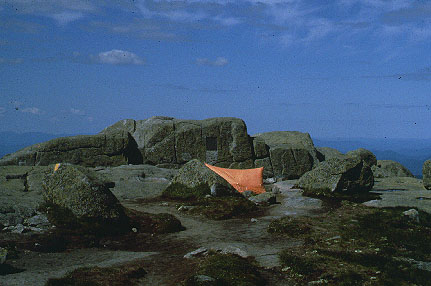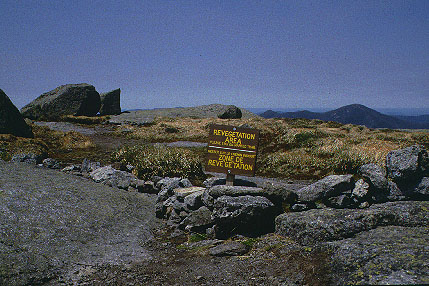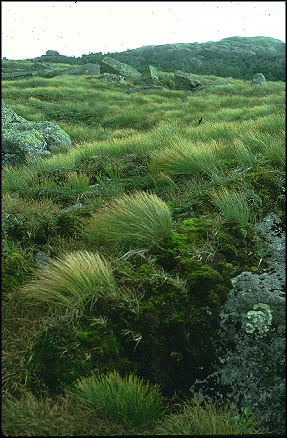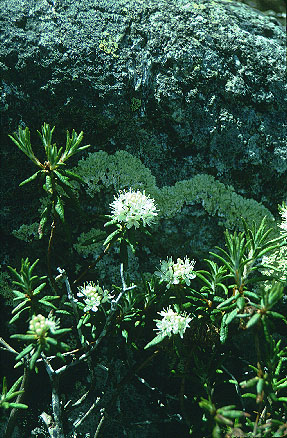 

The Summit Steward Program |
 

The Summit Steward Program |

| A thing is right when it tends to preserve the stability, integrity, and beauty of the bioticcommunity. It is wrong when it tends otherwise. - Aldo Leopold |
| More
than fifty years ago, Aldo Leopold wrote these thoughts in his celebrated essay "The
Land Ethic." Today, on the high summits of the Adirondack Mountains, his words remain
true as we work to preserve a living museum of our natural history. The Summit Steward
Program helps preserve alpine vegetation in the Adirondacks. Our goal is to instill an
"Alpine Land Ethic" in hikers. Finding a Balance - Summit Stewardship: The last forty years have been tumultuous times for alpine communities. The hiking boom in the late 1960s brought thousands of people to the summits who were unaware of the fragile nature of these ecosystems. Hikers walked and camped on the tundra meadows unaware of the damage they were causing. |

Illegal camping on summit
| Evidence of disturbance is quite visible in the High Peaks
today, and to a certain extent the meadows continue to be impacted by hikers who have yet
to meet a Summit Steward or read a sign! Alpine plants are incredibly sensitive to
footsteps because of the environment they live in. Over a growing season, a plant is able
to produce only enough energy to carry out its basic life cycle. They can not compensate
for root damages caused by trampling, and are therefore easily killed by it. When the plants die and their roots are lost, soil that took more than ten thousand years to accumulate is easily eroded by wind and water. It can take centuries for a damaged alpine meadow to recover. |
 |
| As a response to this problem, the Summit
Steward Program began in 1990 as a cooperative effort of the Adirondack Nature
Conservancy, the Adirondack Mountain Club, and the New York State Department of Environmental Conservation. It was modeled after a similar program that began in Vermont on Mount Mansfield in the 1970's. From May to October, Summit Stewards provide an educational presence on the summits that are most threatened by hiker trampling. Stewards spend up to five days at a time in the backcountry interacting with hikers and encouraging them to: * Walk on the trail and solid rock surfaces * Leave the endangered plants in place, do not pick them * Avoid walking on bare dirt or gravel where plants can grow * Keep dogs leashed above timberline * Share the summit steward message with others It's working!: There has been a noticeable improvement in the condition of the alpine meadows. The word is quickly spreading that alpine vegetation is fragile and endangered. With less traffic on damaged areas, colonizing plants can now be seen starting the process of restoration. Two of the more prolific and showy pioneers of disturbed sites are mountain sandwort (Minuartia groenlandica) and three-toothed cinquefoil (Potentilla tridentata).  Minuartia groenlandica These plants, both with white flowers, have an uncanny
ability to grow in the most impoverished and unlikely spots. Mountain sandwort is
often found growing near the trail. These species produce an abundance of seed which makes
them quick to spread and colonize open habitats. Diapensia (Diapensia lapponica), a plant that only grows above timberline in
the northeast, epitomizes this adaptation. The waxy leaves grow so compactly and
close together that the plant is virtually impenetrable and unaffected by the wind. The
soil underneath diapensia can be several degrees warmer than the surrounding air
temperature (Marchand,122). As a result, diapensia is often found growing in the most
extreme sites in the alpine zone. These are the windswept locations that usually do not
have a cover of snow in the winter. The exposed roots of bearberry willow (Salix uva-ursi), another strictly
alpine species in the A close relative of bearberry willow called dwarf willow (Salix herbacea) only shows
its leaves above the surface of the moss it grows under. The rest of the plant is
underground! Dwarf willow is quite rare, and only known to grow on one summit in the
Adirondacks. These extensive root systems help the plants to propagate themselves through
rhizomes, and also store energy for future growing seasons. |
|
| Labrador tea (Ledum groenlandica) bog laurel (Kalmia
polifolia), leatherleaf (Chamaedaphne calyculata), small cranberry (Vaccinium
oxycoccos), and cotton sedge (Eriophorum spissum ssp.vaginatum) are all residents of lowland bogs that also grow above timberline. Some of the alpine plants are species that also occur in more northern lattitudes. In the Adirondacks, these specialized plants are restricted to alpine zones, and therefore they are quite rare locally. A few of them grow on just a couple of summits, the dwarf willow being the extreme example of this. In addition to the diapensia and willows mentioned above, the following are strictly alpine plants in the northeast: dwarf tundrabirch (Betula nana), small birch (Betula minor), lapland rosebay (Rhododendron, lapponicum), alpine azalea (Loiseleuria procumbens), alpine blueberry (Vaccinium boreale), and several gramanoides. Bigelow's sedge (Carex bigelowil) and deer's hair sedge (Scirpus cespitosus) are two of the most conspicuous alpine gramanoides. These two plants make up the sedge lawns that are commonly found on the very tops of Adirondack alpine summits.  |
 Ledum groenlandica
|
| The People Behind Summit Protection: The
Summit Steward Program is supported through generous donations made by foundations, companies and individuals, and by the efforts of the Adirondack Chapter of the Nature Conservancy, the Adirondack Mountain Club and the New York Department of Environmental Conservation. If you are interested in supporting the Adirondack Summit Stewards, please send your contributions ANC/ALT, PO Box 65, Keene Valley, NY 12943. Written by Jeff Lougee, chief steward, 1998 |